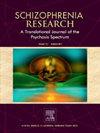Association between the exposome score for schizophrenia and functioning in remitted first-episode psychosis: results from the HAMLETT study
IF 3.5
2区 医学
Q1 PSYCHIATRY
引用次数: 0
Abstract
Background
Environmental risk factors contribute to functional impairment, which can persist even after symptomatic remission of a first episode of psychosis (FEP). To quantify this effect, we calculated the association between exposome score for schizophrenia (ES-SCZ), a cumulative environmental liability score, and functioning in remitted FEP patients.
Methods
Data of 286 participants were derived from the HAMLETT study. General functioning was assessed using the Global Assessment of Functioning (GAF) scale at baseline, when participants were in remission for 3–6 months. ES-SCZ was calculated based on previously validated estimates and included childhood adversity domains (emotional and physical neglect; emotional, physical and sexual abuse; and bullying), cannabis use, hearing impairment, and winter birth. The association between ES-SCZ and GAF was evaluated in three multiple linear regression models, with each successive model including additional covariates.
Results
ES-SCZ was negatively associated with the GAF score, even after accounting for age, sex at birth, education, migrant status, antipsychotic type, and FEP duration [B = −1.51 (−2.78 to −0.24), p = .022]. This final model explained 8.6 % of the variance (R2) in the GAF score, with ES-SCZ being the primary contributor, accounting for 35.5 % of this explained variance.
Conclusions
This study independently replicated the finding that ES-SCZ predicts general functioning in FEP, showing its potential for forecasting functioning in remitted FEP patients.
精神分裂症暴露评分与缓解首发精神病功能之间的关系:来自HAMLETT研究的结果。
背景:环境危险因素有助于功能损害,即使在首次精神病发作(FEP)症状缓解后,功能损害仍可能持续存在。为了量化这种影响,我们计算了精神分裂症的暴露评分(ES-SCZ)、累积环境责任评分与缓解的FEP患者的功能之间的关系。方法:286名参与者的资料来源于HAMLETT研究。当参与者缓解3-6个月时,在基线时使用总体功能评估(GAF)量表评估一般功能。ES-SCZ是根据先前验证的估计计算的,包括童年逆境领域(情感和身体忽视;情感、身体和性虐待;欺凌)、大麻使用、听力障碍和冬季出生。ES-SCZ与GAF之间的关系通过三个多元线性回归模型进行评估,每个连续模型都包含额外的协变量。结果:ES-SCZ与GAF评分呈负相关,即使考虑了年龄、出生性别、教育程度、移民身份、抗精神病药物类型和FEP持续时间[B = -1.51(-2.78至-0.24),p = 0.022]。最终模型解释了GAF评分中8.6%的方差(R2),其中ES-SCZ是主要贡献者,占该解释方差的35.5%。结论:本研究独立地重复了ES-SCZ预测FEP患者一般功能的发现,显示其预测缓解性FEP患者功能的潜力。
本文章由计算机程序翻译,如有差异,请以英文原文为准。
求助全文
约1分钟内获得全文
求助全文
来源期刊

Schizophrenia Research
医学-精神病学
CiteScore
7.50
自引率
8.90%
发文量
429
审稿时长
10.2 weeks
期刊介绍:
As official journal of the Schizophrenia International Research Society (SIRS) Schizophrenia Research is THE journal of choice for international researchers and clinicians to share their work with the global schizophrenia research community. More than 6000 institutes have online or print (or both) access to this journal - the largest specialist journal in the field, with the largest readership!
Schizophrenia Research''s time to first decision is as fast as 6 weeks and its publishing speed is as fast as 4 weeks until online publication (corrected proof/Article in Press) after acceptance and 14 weeks from acceptance until publication in a printed issue.
The journal publishes novel papers that really contribute to understanding the biology and treatment of schizophrenic disorders; Schizophrenia Research brings together biological, clinical and psychological research in order to stimulate the synthesis of findings from all disciplines involved in improving patient outcomes in schizophrenia.
 求助内容:
求助内容: 应助结果提醒方式:
应助结果提醒方式:


